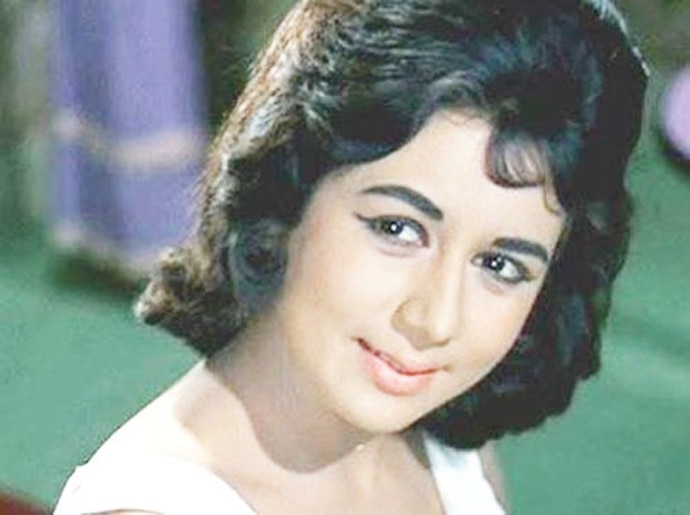Remembering Nanda: An iconic star of the golden era of Hindi cinema

January 8, 2019, is the 80th birth anniversary of an actress who, between the 1960s and early 1970s, lit up the silver screen with her charm and sweet smiles. She was Nanda, an actress who played impressive and varied roles opposite stars like Shashi Kapoor, Rajendra Kumar, Sunil Dutt, Manoj Kumar and superstar Rajesh Khanna.
Her films with Shashi Kapoor and Rajesh Khanna were very successful. She stopped working in the early seventies, making a re-appearance in the early 80s in three films as Padmini Kohlapure’s screen mother. After that, she did not work till 2014 when she passed away at the age of 76.
Born in a film family, Nanda began her career as a child actress. However, her father Vinayak Damodar Karnataki (Master Vinayak) died when she was just eight years old, after which she kept working as a child star to support her siblings. In 1956, her uncle V Shantaram cast her in Toofaan aur Deeya which was the story of a brother and sister. She was 17 years old and gave an impressive emotional performance.

In her film Chhoti Behen (1959), she gave another wonderful performance. 'Sister roles' came her way after that. Dev Anand (under the Navketan banner) produced Kaala Bazar in 1960, casting Nanda as his sister. It was at this time that Nanda struck a life-long friendship with Waheeda Rehman – the heroine of this film.
Dev Anand was very impressed with Nanda’s acting skills and promised her that he would give her a heroine’s role in Hum Dono, the next Navketan venture (1961). And he kept his promise. Not just did he cast her as his wife in the film, he also recommended her for a beautiful lead role in Teen Devian (1965), which was directed by his younger brother Vijay Anand.
She played a glamorous role in this fun film which had Kalpana and Simi Garewal as the other two 'devis'.
These two black and white films played a major role in turning Nanda into a heroine who was equally comfortable playing the traditional Indian woman as well as the westernised damsel.
Dev Anand’s confidence in her acting prowess proved right and she never looked back.
However, it was with Jab Jab Phool Khile (also 1965) that Nanda established herself as an extremely stylish and versatile star who could gracefully carry Indian and western dresses and portray emotions effectively. Through all her performances, her inherent shyness could be seen and felt by the audiences.

For an introvert like Nanda to have played some bold roles, it may not have been easy. She always overcame her shyness when she was in front of the camera. Her tinkling laughter was enchanting.
Shashi Kapoor always said that Nanda was his favourite heroine. They worked together in eight films. Jab Jab Phool Khile (1965) was the biggest hit Nanda played her role to perfection including her performance in the memorable songs 'Pardesiyon se na akhiyaan milaana', 'Na na karte pyaar tumhee se kar baithhe', 'Ek thha gul aur ek thhi bulbul' and 'Yahan main ajnabee hun'.
On this iconic film was based Raja Hindustani, almost thirty years later. Nanda saw it and expressed her satisfaction at the way it had been done.
Her films with superstar Rajesh Khanna – Ittefaaq (1969), The Train (1970) and Joroo ka Ghulam (1972) – were quite successful. Her short role in Manoj Kumar’s Shor (1972) is remembered till date as it featured her in the melodious 'Ik pyaar ka nagma hai, maujo’n ki rawaani hai'.
When Raj Kapoor requested her to play the role of Padmini Kolhapure’s mother in Prem Rog (1982), Nanda could not refuse. Her acting in this socially oriented film is subtle and excellent. She also appeared in the role of a mother in Ahista Ahista (1981) and Mazdoor (1983). In Kanoon (1960) and Ittefaaq (1969), she played very effective roles.

These were songless films with tight scripts and required extremely controlled acting. When Nanda met Dev Anand at a family screening of the coloured version of Hum Dono (1961) fifty years after the film was released in 1961, it was an occasion for shared nostalgia. Both actors were moved to tears.
Like her close friend Sadhana, Nanda too became reclusive and was not seen at social gatherings for years.
However, audiences can never forget this sweet, innocent and stylish actress who lent a unique charm to Hindi cinema, especially in the 1960s. Her costumes, Indian as well as western, were imitated by young women of those days. Her hairstyles were also very popular.
In her ethnic avatar, she looks simply wonderful in Dharti Kahe Pukaar Ke (1969) opposite Jeetendra. A little shy, a little playful, always classy and sophisticated, Nanda will forever be remembered as a prominent actress and iconic star of the golden era of Hindi cinema. A gem of our silver screen.

